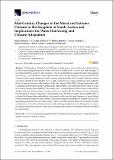| dc.contributor.author | Komurcu Bayraktar, Muge | |
| dc.contributor.author | Schlosser, Courtney Adam | |
| dc.contributor.author | Alshehri, Ibtihal | |
| dc.contributor.author | Alshahrani, Tariq | |
| dc.contributor.author | Alhayaza, Waleed | |
| dc.contributor.author | AlSaati, Adnan | |
| dc.contributor.author | Strzepek, Kenneth | |
| dc.date.accessioned | 2020-11-04T16:52:10Z | |
| dc.date.available | 2020-11-04T16:52:10Z | |
| dc.date.issued | 2020-10 | |
| dc.date.submitted | 2020-09 | |
| dc.identifier.issn | 2073-4433 | |
| dc.identifier.uri | https://hdl.handle.net/1721.1/128353 | |
| dc.description.abstract | The Kingdom of Saudi Arabia (KSA) is a water-scarce region with a dry, desert climate, yet flood-producing precipitation events and heat extremes lead to loss of life and damages to local infrastructure, property and economy. Due to its distinctive natural and man-made spatial features (e.g., coastal features, wadis, agricultural areas) studying changes in the mean climate and extreme events requires higher-resolution climate projections than those available from the current generation of Earth System Models. Here, a high-resolution convection-permitting regional climate model is used to downscale the middle of the 21st century (2041–2050) climate projections of the Community Earth System Model (CESM) under representative concentration pathway (RCP) 8.5 and for a historical time period (2008–2017) focusing on two months (August and November) within KSA’s dry-hot and wet seasons, where extreme events have historically been observed more frequently. Downscaling of climate reanalysis is also performed for the historical time period (2008–2017) to evaluate the downscaling methodology. An increase in the intensity and frequency of precipitation events is found in August by mid-century, particularly along the mountainous western coast of KSA, suggesting potential for water harvesting. Conversely, the northern flank of the Empty Quarter experiences a noticeable reduction in mean and extreme precipitation rates during the wet season. Increasing August heat index is found to particularly make regional habitability difficult in Jeddah by mid-century. | en_US |
| dc.publisher | MDPI AG | en_US |
| dc.relation.isversionof | http://dx.doi.org/10.3390/atmos11101068 | en_US |
| dc.rights | Creative Commons Attribution | en_US |
| dc.rights.uri | https://creativecommons.org/licenses/by/4.0/ | en_US |
| dc.source | Multidisciplinary Digital Publishing Institute | en_US |
| dc.title | Mid-Century Changes in the Mean and Extreme Climate in the Kingdom of Saudi Arabia and Implications for Water Harvesting and Climate Adaptation | en_US |
| dc.type | Article | en_US |
| dc.identifier.citation | Komurcu, Muge et al. "Mid-Century Changes in the Mean and Extreme Climate in the Kingdom of Saudi Arabia and Implications for Water Harvesting and Climate Adaptation." Atmosphere 11, 10 (October 2020): 1068 | en_US |
| dc.contributor.department | Massachusetts Institute of Technology. Center for Global Change Science | en_US |
| dc.contributor.department | Massachusetts Institute of Technology. Joint Program on the Science & Policy of Global Change | en_US |
| dc.relation.journal | Atmosphere | en_US |
| dc.eprint.version | Final published version | en_US |
| dc.type.uri | http://purl.org/eprint/type/JournalArticle | en_US |
| eprint.status | http://purl.org/eprint/status/PeerReviewed | en_US |
| dc.date.updated | 2020-10-13T13:24:40Z | |
| dspace.date.submission | 2020-10-13T13:24:40Z | |
| mit.journal.volume | 11 | en_US |
| mit.journal.issue | 10 | en_US |
| mit.license | PUBLISHER_CC | |
| mit.metadata.status | Complete | |
